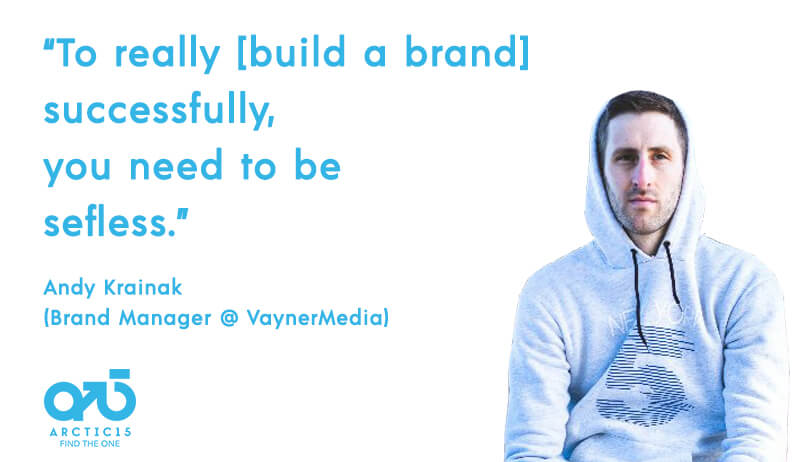A few days ago, we asked Brand Manager at VaynerMedia and Arctic15 speaker Andy Krainak for marketing advice. If you do not know Andy, you should. He is not just another Brand Manager at another average company. Andy is the brand manager of Gary Vaynerchuk (Gary Vee), serial entrepreneur, early investor in Twitter, Uber, Snapchat and Venmo, CEO of VaynerMedia, and an influencer with millions of followers across the internet.
Of course, Gary, being the marketing expert that he is, handles the execution of his personal brand, but much of the archetyping and ideas also come from Andy and the rest of “Team Gary”. For this reason, we wanted to pick Andy’s brain about building a brand, personally and as a business.

Q 1 : What’s the value of building a personal brand?
Andy: Connections with other people. The value of building a personal brand is same value you would receive from building a reputation with other people who share similar business interests or hobbies.
Your business opportunities are directly correlated to what people know about you and how they feel when your service or product is mentioned. Though it may take time, opportunities for promotions and sales will come as a result of your reputation.
Q 2: From your work with Gary, do you think entrepreneurs and founders might get a different kind of value from building a personal brand?
Andy: Yes, but too many think about building a personal brand in a selfish way, and to really to do it successfully you need to be selfless. Give value to others without the expectation of anything in return.
In his vlog and podcast Gary Vaynerchuk has said multiple times that people want to do business with him because he shared his best ideas and expertise for free. He did this consistently, and now he alludes to people likely to spend tens of thousands of dollars just to get in a room with him for an hour. Think about your audience and give value to them without focusing on what you might get back and when you’ll get it.
Q 3: Does personal branding strategy also work in the context of a business? What are the similarities and differences?
Andy: Of course, it’s branding around a lifestyle, belief or idea as opposed to a person behind a specific lifestyle, belief, or idea.
You might think there is a vast difference between marketing a business and a person. Turn that thinking on its head and use content to tell the story of your business almost as if you were telling the story of a person.
Q 4: What practical tips can you give for altering the marketing strategy of a personal brand versus marketing a business?
Andy: The strategy is essentially the exact same, tell meaningful stories and bring value to others. How and why you do it is what differs, most businesses struggle identifying with what their story or content is to create, whereas with personal brands it can be easier to identify.
Q 5: How do you figure out what content to create for your audience?
Andy: By identifying the axis of what content you’re capable of creating and what your audience really wants to hear from you.
Don’t overthink the content. Consider what might be valuable for your audience, whether that be the life experience you have, the unique expertise of your CTO, or whatever your brand has to give. The next part is to actually make content in audio, video and written form to share it.
Q 6: What are the steps, if any, of determining who your audience is and what they care about?
Andy: One, put out content online. Two, analyze and learn who reacts or engages with your content. Three, repeat steps one and two.
After you share your content, watch who reacts to it and consider why. Comments they leave or even simply asking them what they liked about your content can tell you a lot (this is where sending a direct message to a follow can help). Make sure to avoid idealizing a certain audience. You may have had a totally different market in mind but you also may have misunderstood who would benefit from your expertise.
Q 7: What’s the most common mistake of brands when producing and putting out content?
Andy: They make ads instead of content.
The difference between an ad and content is in an ad gives value to you, while content gives value to your audience. If your content is consistently pushing a sale – i.e. “go buy our program” or “check out the podcast link in our profile!”, it is an ad. Content is meant to educate, entertain, or inspire your audience without looking to convert at that very moment.
Q 8: What’s the marketing mistake that brands make which you find most interesting?
Andy: Mismanagement of millions of marketing dollars on ads or ad products that don’t impact sales.
You may not have millions to mismanage but actually try and analyze what ads are working and where they are working. Also consider if you simply are not making good ads, and test different approaches.
Q 9: Why do you believe businesses struggle to identify their story and content more than personal brands, and what can they practically do about it?
Andy: Both can struggle, but businesses tend to think they don’t have anything interesting to share or talk about for their ideal audience to consume. With personal brands it can be easier because humans naturally have a better understanding on their own content interests and the interests of their audience.
A practical way to come up more content ideas is to think about what would be of value to your audience to learn or hear about from you, regardless if it’s something that your business actually sells.
Businesses or personal brands struggling to create more content can also target a long form or “pillar” piece of content such as a podcast, or video show that will service micro-content to post across their social media channels.
Interested to ask Andy your own questions? Join his workshop on June 6th at Arctic15





